Interview by Carol Wright | Artwork by V.V Nunley
V.V Nunley, a painter based in New Jersey, creates works with unique perspectives and characters. She talked to NYOTA about how she strengthened her painting skills, the Western character in her artwork, and her advice for aspiring artists.

What initially sparked your interest in art?
Since I was little, I’ve always been interested in the way things look. I think it’s just how my brain works. I spent a lot of time as a kid simply sitting and staring at toys and illustrations and tchotchkes because I liked how they looked, and I think drawing goes hand-in-hand with that because it’s the next step— to then make the thing you want to see.
Once you decided you wanted to pursue art as a career, what did you do to strengthen your skills?
Paint. More. Constantly. All the time. Skills can only be strengthened by doing over and over again, and the more time I could spend painting, the faster my progress would accelerate. I figured the best environment to facilitate this would be to do an MFA program. But in order to get into a good MFA program, I had to first do a post-baccalaureate program. And so, that’s how I ended up committing myself to painting nearly every single day without fail for four years straight.
Your painting style is very unique. How did you go about finding your aesthetic as a painter?
First, I had to discard the idea that “real” paintings should look a certain way. That was probably the hardest part, because it was more of a mental block and crisis of confidence than anything else. Then, I made about a hundred terrible paintings over the course of a year while trying to pin down how far I should stray from realism, and then how far to lean into cartooning. I figured out that my strengths lay in drawing, and that I found it satisfying to paint decisively, flat, and hyper-clean. And on top of that, I collected images from cartoons, illustrations, mangas, and animations I really liked and tried to pinpoint exactly what about it was pleasing to me. It was important to me to find a style that echoed familiar visual languages but was still recognizable as mine. I drew and redrew and studied to build my own style— it’s important that it becomes mine, that’s part of the substance underneath it. Otherwise, it’s just a poor imitation of someone else’s authenticity.
Do you like to find different ways to challenge yourself with your pieces through playing with perspective?
Sure. Every piece I try to do something different than I’ve done before, and perspective is one of the things I can play with to make an image more interesting.


What inspired the cowgirl/Western character that stars in a lot of your pieces?
I made a painting called “When you see me rollin’ up pops, you step aside” which depicts a cowgirl walking through the desert and stepping on a snake, and I really liked making a themed painting. I suddenly had a setting, props, a color palette, and a character, and I realized I could use these as an access point to make paintings about a painful break-up and the subsequent emotional hangover. Previously, I had found it difficult to make work about deeply personal subjects because they always felt clumsy and obvious. But now I had built a metaphorical space in which to confront and struggle with my turmoil, like the protagonist who, alone, encounters and fights with various obstacles in her journey.
Are there certain songs, images, or movies that influence your pieces and the stories you tell through them?
Let’s say since the start of 2024, these are the things I’ve been looking at and have been inspired by:
- Movies:
- Akira
- Spirited Away
- Alien
- The Lady from Shanghai
- Bladerunner
- The Maltese Falcon
- Tekkonkinkreet
- The Matrix
- Stray Dog
- Television:
- Megalobox
- Bee and Puppycat
- Scavenger’s Reign
- Books:
- The Big Sleep
- Farewell My Lovely
It’s clear that the little details in each of your pieces are very important. Do you have a process when it comes to choosing which colors or extra objects/animals will be added into a piece to help bring it to life?
Since the paintings are themed, I have a roster of “props” that could be used in this world. And then from there, whatever the props are doing or how they’re designed is dictated by what the painting is about. I know they can’t really be deciphered by anyone other than me, but that’s okay. I decided that as long as the viewer gets the distinct feeling that they are specific and there for a reason, that’s enough.
What advice do you have for aspiring artists?
Keep drawing and painting as much as you can. When you’re just starting out, it’s okay to try on other artist’s styles and take it for a spin. By imitating it and making a painting in that style, you can understand how it was constructed. Some things you can only understand by doing. Eventually, your own style will emerge. And it’s okay if your painting is bad. You have to make bad paintings to make good ones. In fact, I’d say you have to make a lot of bad paintings to finally make a good one. And you can’t make imaginary bad work in your head— you have to physically make it. You have to make the bad painting and then sit back and look at it and figure out why it’s not working. If you allow yourself to be too scared to make something that might turn out bad, you’ll become paralyzed and never make anything at all. Keep pushing. Keep making. Keep working. It’ll pay off in the end, because what you want to say is worth making art about.




